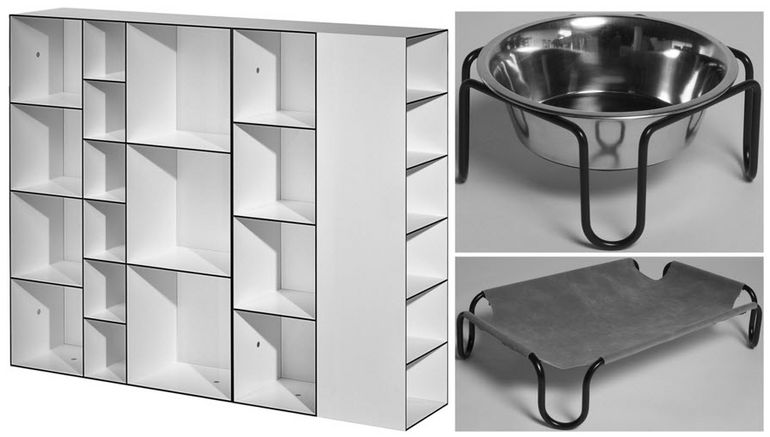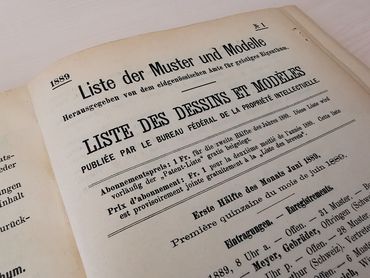When you’ve finished reading newspapers and flicking through brochures, where do you put them? Willi Glaeser came up with a stylish solution back in 1989. His paper holder made it into various design books, as well as the Design Store of the Museum of Modern Art in New York. Glaeser’s creation is often included in the list of classic Swiss designs. The 82-year-old entrepreneur and designer shared the story behind his design with the Swiss Federal Institute of Intellectual Property (IPI). His business partner Thomas Merlo also spoke to us about his experience with intellectual property protection.
For IP professionals
This is the portal for professionals working in the field of intellectual property. Here you'll find direct access to all necessary resources.
Quick links
How a stack of paper inspired a classic design
More than 30 years ago, Willi Glaeser designed a used-paper collector, which soon became established. However, not long after it was launched on the market, people started to copy Glaeser’s creation. Since then, his business partner Thomas Merlo has been consistently taking action against counterfeiters.
![[Translate to English:]](/fileadmin/_processed_/2/6/csm_papiersammler_glaeser_portrait3_926fdc64e0.jpg)
The lightbulb moment
It’s the late 1980s: Willi Glaeser is walking through his workplace. He notices the piles of paper on all the desks once again. “Over 90% of them were A4 sheets,” recalls the designer on the phone. An idea for a paper holder instantly pops into Glaeser’s mind. He produces a draft on a piece of paper on the dining table in his home. “It took me three hours,” laughs Willi Glaeser. Paper recycling was already being widely promoted back then. He thought that if that’s what we should be doing, then the storage object needs to be visually appealing.
Success
“The product took off immediately. I brought paper collecting into the mainstream,” says Willi Glaeser with pride. “Until then, it was mainly the Greens who collected used paper. This stylish paper collector made it trendy for everyone.” He says that the time was right – he seized the opportunity at the optimum moment, and a bit of luck was also at play. His business partner Thomas Merlo took care of the marketing from the beginning. As of today, they have sold two million paper holders.
Carpenter, designer and managing director
“The product took off immediately. I brought paper collecting into the mainstream,” says Willi Glaeser with pride. “Until then, it was mainly the Greens who collected used paper. This stylish paper collector made it trendy for everyone.” He says that the time was right – he seized the opportunity at the optimum moment, and a bit of luck was also at play. His business partner Thomas Merlo took care of the marketing from the beginning. As of today, they have sold two million paper holders.
Vision and inspiration
He has a clear vision of what a design should be. Above all else, the product should improve a situation. “If an object is useful, it becomes interesting. I find it a pity if a chair looks great, but is just uncomfortable,” says Willi Glaeser. He gets inspiration for new designs on forest walks. “I’ve gone to sleep with an idea in my head before and woken up with the development planned out. There are no rules when it comes to the creative process.”
A licence to hunt copycats
In the early 1990s, Willi Glaeser turned to Thomas Merlo for the marketing and protection of the paper collector. “The market was new to me, and I was faced with copies straight away,” he recalls. When it was first sold, the paper collector hadn’t been protected yet, which made it difficult to enforce the rights. After a long application process aided by an attorney, Thomas Merlo succeeded in protecting the object retroactively with the IPI as a three-dimensional mark (see infobox below). “Thanks to the entry in the register, we can take effective action against counterfeiters and prevent copies,” says Thomas Merlo.
(Kopie 6)

“I’ve always defended the original well”
Mr Merlo is never short of work. “I’ve kept the market clear and always defended the original well in Switzerland,” says the marketing and IP right specialist. In many cases, it’s enough to just make copycats aware of their actions. “Most of the time, we’ve been able to find an amicable solution,” he tells us. There was even a case of a customer selling copies of the product. In such situations, it’s common to negotiate a licensing agreement. This allows those concerned to sell the original via their own distribution channel for a fee. Merlo also defends the paper collector abroad. In Germany, a key market, the Act against Unfair Competition and interim injunctions are employed. In addition, Thomas Merlo works with a Hamburg-based attorney, who monitors the market.
Competitors are suddenly being more cautious
“You have to consistently defend your creation. Otherwise the registration is of no use. The fight against counterfeiters costs a lot money, but we’ve been able to establish the original on the market and keep the price stable up to now,” he says. Word gets around when a company takes consistent action against copies. It makes its competitors more cautious. This approach is working for Thomas Merlo & Partner AG: the newspaper holder is still their best-selling product.
Back to Willi Glaeser: he tells us that he still has a supply of the exclusive chrome-nickel steel edition paper holders in his apartment. Every so often, he gives one away to visitors. On his 80th birthday, Willi Glaeser transferred the rights to the paper holder to his business partner Thomas Merlo. “He really carried the project through back then and helped to make the product a success.”
Infobox: The paper holder is a 3D trade mark
In 1995, the paper holder was protected as a three-dimensional mark at the IPI – with retroactive priority of use from 1 January 1990. A three-dimensional trade mark can be a three-dimensional sign affixed to a product, for example the Mercedes symbol on a car. It’s also possible to protect the product itself or its packaging (e.g. the Coca-Cola bottle or Toblerone packaging), as long as the shape is distinctive. As with other types of trade marks, protection can be renewed as many times as needed. In accordance with the IPI’s current practice, however, shapes are now only registered as trade marks in exceptional cases. They are primarily protected as designs.
Not sure how to choose the right type of trade mark? Find out more here.



